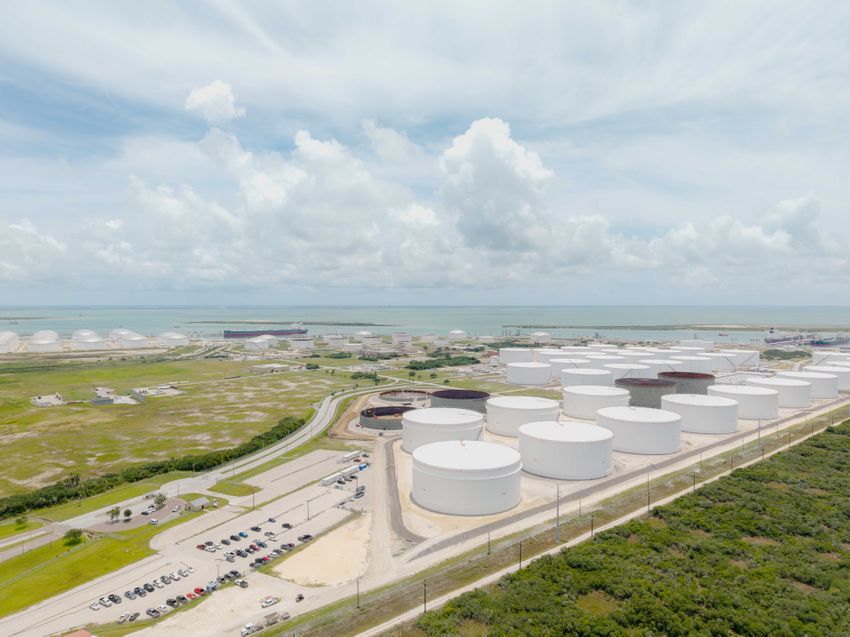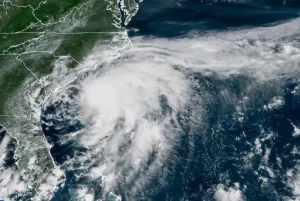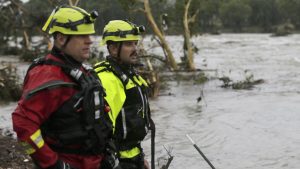Chris Carlton constructed his home in Ingleside during 2008, when the area remained a quiet fishing community.
“We represented this small pocket of paradise. People knew this region for fishing long before petroleum made its mark,” Carlton explained.
Since that time, over twelve oil and chemical facilities have emerged along the coastline. These companies chose the location for its access to transatlantic shipping routes, affordable fossil fuel supplies, and permissive local regulations.
Now, a fresh industry approaches — one that has targeted winning over the local community as its primary goal.
Norwegian fertilizer giant Yara partnered with Canadian pipeline operator Enbridge in 2023, revealing plans to construct the first ammonia plant in Ingleside. Yara stated that the chemical – a crucial fertilizer ingredient – would “significantly contribute to our strategy of decarbonizing agriculture” and supply a “clean” fuel for shipping and power generation.
The new facility would generate up to 8,000 metric tons of “low-carbon” ammonia daily by 2030, establishing it as one of Yara’s largest-ever operations. The companies plan to export the chemical to Europe, Asia and other destinations.
The project’s success depends on securing support from the local city council, which has thus far supported concerned residents who oppose the plant.
During the past two years, the companies have initiated numerous social programs that touch nearly every aspect of community life, from establishing a food bank to providing free baseball tickets and children’s shoes – actions that some residents characterize as a “charm offensive.” The project has named itself “YaREN” in reference to the Norwegian word “ren” meaning “clean.”
However, many locals, along with experts and campaigners, argue that the plant could deliver devastating impacts on the environment and human and marine health.
Ammonia supporters, referring to a compound of nitrogen and hydrogen, emphasize that it burns cleanly, releasing no carbon dioxide. However, fossil fuels currently produce more than 99% of ammonia, generating 450 megatons of carbon dioxide annually.
DeSmog analysis reveals that Ingleside’s new plant could demand more gas than Switzerland, Bulgaria or Denmark consumes each year.
Yara and Enbridge claim they will decarbonize ammonia production through carbon capture and storage (CCS) – a process where industrial emissions get captured and stored underground, producing so-called “blue ammonia.”
Many residents and experts express skepticism about these claims. Carbon capture has faced widespread criticism for failing to achieve its promised potential. The technology does nothing to address emissions from gas extraction or ammonia use, which currently represents the largest share of emissions from the gas once farmers spread it on fields as fertilizer.
Ammonia poses high toxicity risks to humans and animal life when leaked. The new plant would become a major source of air pollutants that can trigger respiratory problems, heart attacks and premature death, according to DeSmog analysis.
With chemical demand booming, the Ingleside plant represents just one of 32 new facilities planned across the U.S., with the country’s ammonia production set to quadruple if all proposed sites proceed. The majority locate in Texas or Louisiana.
A spokesperson for Yara, Enbridge and YarEN told DeSmog, “We are committed to safety, working with the community, protecting people and the environment, and providing energy to the people who need it.”
However, Melanie Shafer, who has called Ingleside home since childhood, says her community faces being “bought out by cheap tricks,” referring to the companies’ efforts to secure local support.
“All around, my community will suffer from the air pollution,” Shafer states. “I’ve lived here my whole life, it’s my home, and watching it transform into a wasteland breaks my heart.”
“They’ve arrived here because Texas maintains lax environmental laws,” Ingleside resident Janet Laylor told council members during a public meeting in January 2024, where officials discussed YaREN’s local permit. “They knew they could establish operations here because this represents the place to go to pollute.”
“David and Goliath”
The $5 billion facility would rise on Enbridge’s existing “energy center” adjacent to the town, where the company already operates the country’s largest oil export facility. To start construction, YaREN requires permission from the local city council plus three environmental permits from the state regulator, the Texas Commission on Environmental Quality, which will evaluate expected air and water pollution levels, and the water usage amount.
Hundreds of residents responded to the public consultation on the air pollution permit, and dozens have voiced concerns at council sessions and public meetings with the companies.
Campaigners have described the battle between concerned locals and the companies as “David and Goliath.” Norway’s Yara stands as the world’s biggest ammonia trader and Europe’s largest fertilizer producer, while Ingleside operates as a former military town with fewer than 10,000 residents.
YaREN has invested substantially in winning over this population, which consists of lifelong locals, retired oil and gas sector workers, and recreational fishers who manage a volunteer fire department.
Last year, the companies hosted and attended over 200 local events and contributed more than $200,000 for projects and community programs. Their initiatives have ranged from organizing a blood donation drive and purchasing lunch for the local police force, to visiting local schools and colleges to “build relationships” and offer career advice. They state the factory would provide up to 4,000 jobs during peak construction and up to 200 once operational.
YaREN’s community efforts have appeared prominently on social media, including a video on its Facebook page where teachers from a local school thank the companies for donating shoes as they tie laces on brand-new sneakers. The page also features multiple posts about an event celebrating Earth Month in April, where the company distributed free drought-resistant native plants.
“Swing by, grab some greenery, and be part of a sustainable future,” YaREN posted. “We are strengthening the roots of our connection to the community.”
Some locals have supported Project YaREN, with Facebook posts stating, “Looking forward to the economic growth for our area,” and “A community cannot grow without industry.” However, many express concern about the charm offensive, particularly the company’s apparent focus on local schools and teachers.
Melanie Shafer, who has two children, submitted a formal complaint to the local school district board about the company’s actions, which she said, “raise serious ethical and legal red flags, especially when conducted in front of impressionable minors and within publicly-funded educational spaces.” The proposed plant will sit two miles from Ingleside Primary School.
“These are not benign gestures, these are strategic efforts by powerful corporations to secure local goodwill in anticipation of controversial projects,” she wrote. In its response to Shafer, reviewed by DeSmog, the board stated it “recognizes the importance of economic development and the potential benefits industry projects can bring to our community. The district remains neutral on all Project YaREN endeavors.”
Steve Diehl, who served as a city council member from 2019 until last month, agrees with Shafer: “It’s propaganda building,” he says, referring to a local storefront that YaREN has rented since 2024 to meet community members, where it hosts events with “experts available to answer your questions one-on-one.”
Last year, Diehl filed a motion to deny YaREN permission to produce ammonia at the plant. During a four-and-a-half-hour meeting in January 2024, where dozens of residents spoke against the plant, the local city council unanimously voted to support Diehl’s motion, refusing permission to the companies.
The decision represented a major victory for concerned residents – unusual in a state that hosts hundreds of chemical plants and where campaigners rarely receive this level of political backing.
YaREN intensified efforts to win over the community following the meeting — creating its Facebook page in April, hiring a local nonprofit organizer to lead its engagement in June, and launching a series of paid social media ads about the “safety” of and “tax revenue” from the project in August.
A spokesperson for YaREN, Yara and Enbridge acknowledged that “residents have questions about the project,” and stated that they had opened the information center in response to this. Project YaREN is “actively investing in Ingleside and the greater Coastal Bend community through partnerships, education, and workforce initiatives,” they added.
For now, the project’s decision remains uncertain. YaREN continues pushing forward, having submitted its requests for the three TCEQ permits since the meeting, but must return to the city council for approval before construction begins. Diehl thinks the company may have waited until he left office; he stepped down before local elections in May.
“I hope that’s not the case,” he says.
Toxic Air
The community’s concerns focus largely on health risks associated with the plant.
YaREN’s application to TCEQ to emit air pollution shows that the factory would become a significant source of pollutants such as nitrogen oxides, which can trigger asthma and other respiratory problems, and very fine particulate matter known as PM2.5, which can cause everything from diabetes to premature birth.
Companies like Yara and Enbridge have targeted the Gulf Coast due to its access to cheap shale gas and proximity to Atlantic Ocean shipping routes. Texas leads the country in natural gas production, accounting for around a quarter of all production from its shale basins. Ingleside residents fear that chemical companies choose Texas for its reputation of poor enforcement of pollution controls and other regulations.
In August 2024, the TCEQ provisionally granted the air pollution permit to the companies, stating that the new facility “will not violate any state or federal air quality regulations.”
Yet, local campaign groups argue this conclusion relied on inadequate data. The regulator operates numerous stations for monitoring air pollution throughout Texas, but none exist in Ingleside. The closest operates across the bay in Corpus Christi, approximately 20 miles away.
For any new factory, the TCEQ must determine whether the additional emissions would push the region beyond legal limits. However, due to the lack of local data, both TCEQ and YaREN relied on figures from the Corpus Christi stations to demonstrate that the new facility would not breach these laws.
For nitrogen dioxide pollution levels, a form of nitrogen oxide, YaREN used figures from a different station in Beaumont, a four-and-a-half-hour drive and almost 300 miles from Ingleside.
The Coastal Watch Association argues that the figures from these monitoring sites significantly underestimate the pollution amount already present in the town. The group, which leads the campaign against YaREN, operates its own air pollution monitors in Ingleside and the wider San Patricio County. Its data, reviewed by DeSmog, shows that annual averages for fine particulate matter known as PM2.5 pollution already far exceed federal limits and more than double the limit recommended by the intergovernmental World Health Organization.
YaREN did not respond to questions about expected air pollution and safeguards against it, or accusations that permit documents failed to include adequate data.
Ingleside resident Melanie Shafer told DeSmog that her family already experiences pollution effects. Her son has severe asthma, and her mother suffers from a rare autoimmune disease, with symptoms that worsen due to poor air quality.
“Some days we can’t go outside because my son says, ‘mom, the air’s so thick, I can’t breathe,'” Shafer explains.
The family expects to leave the town within the next few years. “This was home, this is where we established roots. I wanted to raise my kids here, it’s a great place to grow up,” Shafer says. “But we’re going to have to move and settle again. My kids will have to make new friends. We’ve been sold out for money.”
This scenario occurs frequently in the state, according to Beth Gardiner, a journalist and author of the book “Choked: Life and Death in the Age of Air Pollution.” Texas remains “notorious for being very pro-industry, and a very lax environmental enforcer,” she says.
“If you speak to people down there, they will say that TCEQ will give a permit to anybody. They’re not doing an adequate job to protect health and the environment.”
A spokesperson for TCEQ declined to comment on “pending permits or statements from outside groups at this time.”
Targeting Texas
Industrial expansion in Texas and neighboring Louisiana has historically targeted low-income, predominantly Black, Brown and Indigenous communities. While Ingleside earns only slightly less than the U.S. average, around half of its residents identify as Hispanic or Latino. Across the U.S., Black and Hispanic people face the highest likelihood of dying from PM2.5 pollution.
Along with the impacts of this pollution, residents also fear an industrial disaster. When inhaled, ammonia can burn or corrode body tissues, including the lungs and respiratory tract. Major ammonia leaks occur rarely, but the Coastal Watch Association argues the consequences would prove too severe to risk. Texas operates no monitors for ammonia detection.
“We’re right along the fence line [of the proposed site] and any sort of disastrous release would put our whole community at risk,” says Payton Campbell, who runs the air monitoring program at the Coastal Watch Association. Ingleside lacks a hospital, with the nearest one in Corpus Christi around 30 miles away, and only has a volunteer fire department. Campbell fears that the town would struggle to respond to a major emergency.
In March, the federal Environmental Protection Agency announced that it would “revisit” stricter PM2.5 limits introduced under President Joe Biden, saying they had “served as a major obstacle to permitting.” In April, the Trump administration invited 500 existing industrial facilities to apply for an exemption from the federal limits on the amount of air pollution they can emit – including nearly 100 in Texas, the largest number of any state.
Campbell believes that whatever decision emerges about YaREN now will establish a precedent for the future of ammonia in the area. “It all depends on this facility — whether they can prove it can be built. We have to focus on stopping this first one, or there will be more to come,” he says.
‘Greenwashing Our Community’
The ammonia industry argues that plants like YaREN will prove essential to decarbonize energy-intensive sectors – offering what they call a “low-carbon” fuel to run ships, provide energy and produce more “climate conscious” fertilizers. Globally, ammonia demand expects to triple by 2050, driven by these new “sustainable” markets and expanding fertilizer use.
The majority of ammonia production converts natural gas into hydrogen, which then reacts with nitrogen that has been separated from the air. While YaREN will rely on gas, the companies claim they will “capture 95% [of the] carbon dioxide” from the process using carbon capture and storage to produce so-called “blue ammonia.”
The carbon capture project – which would be operated by Enbridge alongside several other companies and eventually serve multiple local plants – would transport the captured carbon dioxide southwest through 64 miles of pipeline. The destination would be a storage facility on the 825,000-acre King Ranch cattle and cotton farm, where workers would pump it underground for storage.
Yet, existing projects have repeatedly failed to achieve their promised capture rates, and to date, no single project has captured 95% of greenhouse gas emissions. The technology would also only capture emissions at the plant, doing nothing to reduce the majority of emissions, which arise from natural gas extraction or from ammonia use.
Experts warn that increasing blue ammonia production could become an escape route for fossil fuel use. YaREN could require as much as 3.5 billion cubic meters of natural gas every year for its ammonia production, according to DeSmog’s calculations.
To better meet gas demand from its Ingleside site, Enbridge develops a new 18-mile gas pipeline. The project would connect the site to Enbridge’s existing Texas Eastern Transmission pipeline, which runs 9,000 miles from the state to New York, and receives fuel from fracked shale gas. Shale gas extraction releases large volumes of the potent greenhouse gas methane as well as multiple toxic chemicals and pollutants into the air and water.
YaREN and Enbridge did not respond to questions about whether construction of the gas pipeline depended on the ammonia facility’s approval.
Campbell, from the Coastal Watch Association, believes that YaREN’s focus on promoting the chemical as low-carbon forms part of a wider trend among chemical and oil and gas companies in the region.
“There’s a constant greenwashing campaign being waged from industry against our entire community,” he says. “Companies constantly tout how environmentally friendly they are, but they’re just getting permission to pollute.”




